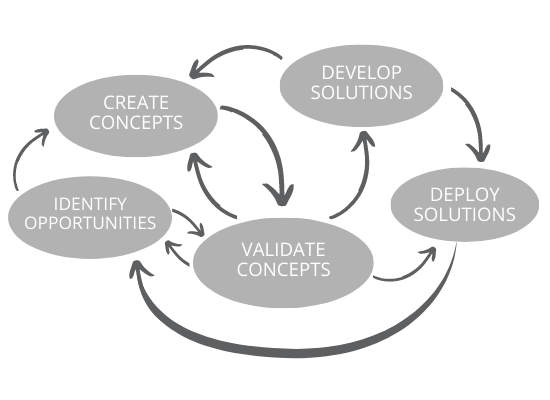
Applying the ISO Innovation Management Standards in Japan and Australia
Posted 4 years ago
At a recent Impact Innovation Lab event, we were joined by Hiro Nishiguchi, CEO of Japan Innovation Network (JIN), and Cettina Raccuia, Head of Royal Auto Club WA’s CoLAB, to unpack real-life examples of how the standards are re-shaping the practice of innovation management across the world.
Hiro provided insights into how businesses in Japan are approaching innovation management, including how the standards have helped companies create new value, grow technological capabilities, and accelerate innovation, while Cettina discussed how she has been able to use the standards to reimagine RAC and support the continual exploration and experimentation of new ideas.
Practical application of the ISO Standards
(Learn more about the ISO Innovation Management Standards here.)
The Japan Innovation Network was established to improve the success ratio of Japanese organisation’s innovation activities, by promoting growth and transformation through systematic innovation management and project support. JIN created their network independently from the Japanese government, so as to not be influenced by changing pollical strategy. Initally, the Japanese government had a strong focus on startups, however after a few years the Government realised there was significant value in larger enterprise. The Government then engaged JIN to assist with the engagement, connection, and support to larger enterprises due to the significant network and solid foundation they created.
From their global research and work supporting the rollout of the standards, JIN identified the following key findings:
Most organisations are still unaware of standards.
There is a clear need for more awareness across Japan and the rest of the world of what the ISO Innovation Management standards are, and how they can help drive best-practice innovation management. Workshops and coaching on the standards, such as the regular sessions run by Impact Innovation, are an effective way to build awareness, but broader awareness would encourage further adoption. Cettina agreed, and mentioned that many Innovation Managers in her Australian network are still unaware of the innovation standards as well. Cettina believes it is important to promote the standards to others.
For those who are implementing the standards, there are some common factors to their success
Some organisations are implementing the standards – however there is a clear distinction between those that are finding success and those that aren’t. It is not enough to read and understand the standards, they also need to be used and applied. Three common factors have been identified across all organisations successfully implementing the standards.
SUCCESS FACTOR ONE: Understanding the importance of the innovation system
Hiro pointed out that all organisations implementing the standards effectively have one thing in common: good management of their innovation systems. From a senior management level, they have a clear understanding of the necessity of a strong innovation management system and they clearly understand the difference between an invention and innovation. There is a common misconception in large organisations that creating inventions is innovating. However, innovation is the value that comes from the invention. Systems thinking is also extremely important, and something that innovation teams should be trained to understand and apply.
Cettina supported this insight, adding that it is also critical to have a strong understanding of what innovation means to the organisation. For RACWA, it is driven by a desire to connect to members and customers and how they can adapt as an organisation to stay relevant to their community. This has evolved with the organisation over time. Cettina also reiterated that it is not the purpose of an innovation system to simply create intellectual property – it goes far beyond new products and services. RACWA have an offsite corporate venturing arm of the business, which includes a fund that invests in early-stage businesses. They often have to show progress around their business model. Being held accountable in this way ensures value created and outputs generated are the metrics that drive the system.
“Organisations must have a clear understanding of the necessity of a strong
innovation management system, and they must clearly understand
the difference between an invention and innovation.”
SUCCESS FACTOR TWO: Regular assessment and adaption of the innovation system
Organisations successfully applying the innovation standards regularly assessed the performance of their system according to the guidelines set out in the standards, to identify root causes of disfunction or underperformance.
In these organisations, upper and middle management and innovation teams gain a deep understanding of how their innovation management system is operating and performing. Through system assessments that allow the organisation to scan the system, identify root causes of underperformance and address gaps, they are able to regularly manage and improve the innovation system to ensure it performs optimally. JIN often help Japanese organisations with this process through an assessment similar in nature to Impact Innovation’s Innovation Navigator™ tool.
At RACWA, they have embraced the recommendation in the standards to constantly monitor the innovation system by establishing a dedicated team responsible for answering the question: “How do we adapt what we are doing in our current lines of business to be able to manage the change that our members are seeing in the real world”.
This is done by working across the organisation and creating connections between business units. Cettina’s team helps build, navigate and nurture pathways and accountability of new ideas that cut across the organisation. They use systems and design thinking, so not just designing solutions for the members but designing solutions for the organisation that fit within the system. They constantly are working on how to make this process more rigorous and scalable for the organisation.
“It is critical to scan regularly in order to gain a deep understanding of how the
innovation management system is operating and performing, to identify
root causes of underperformance and address gaps.”
SUCCESS FACTOR THREE: Non-linear approach to innovation
Organisations that have adopted a non-linear process to innovation have a much high success rate of those that have a traditional linear pipeline (Impact Innovation diagram below, based on the ISO standards, explains this process).

The non-linear approach to innovation described in the ISO Innovation Management standards was created from global intelligence from organisations to explain a process that has been proven to generate better results.
Cettina admitted that when her team was implementing the standards, there was a re-education process to go through about what standards can do and how they can benefit the organisation. For RACWA, they see the standards as a source of collective global intelligence that can be used to test the organisation’s own thinking. The standards are there as a guide and can be molded to any industry.
Where to from here?
RACWA plan to continue using the standards to guide best-practice innovation management. Cettina shared:
- CoLab was launched in Sep 2021 – with the purpose to nurture ideas within the organisation with members.
- RACWA will continue to develop the corporate venture fund to explore ideas outside current business areas, unbranded that allow different types of risks that would not normally be able to explore if it was branded
- They will also work on the cultural aspect of the system. They understand that people underpin the entire system and RACWA want to support and encourage a culture of innovation and allow the space for people to contribute to doing things differently.
- For the standards – continue assessing the existing system and understand what makes sense to implement and improve what the organisation are currently doing.
JIN plans to do more work with large enterprises across Japan, continuing to inform the establishment and maintenance of innovation systems using the standards as a guide. Hiro said:
- After 9 years of operation, JIN is now formalising how they help other organisations in Japan to transform: https://ji-network.org/en/activity
- They are growing hundreds of success cases throughout Japan for others to learn from.
- Future plans include working with international partners to expand their work.
Click here to watch a recording of this event.
To be invited to future events exploring the challenges and opportunities for innovation managers, join the Impact Innovation Lab here (it’s free).